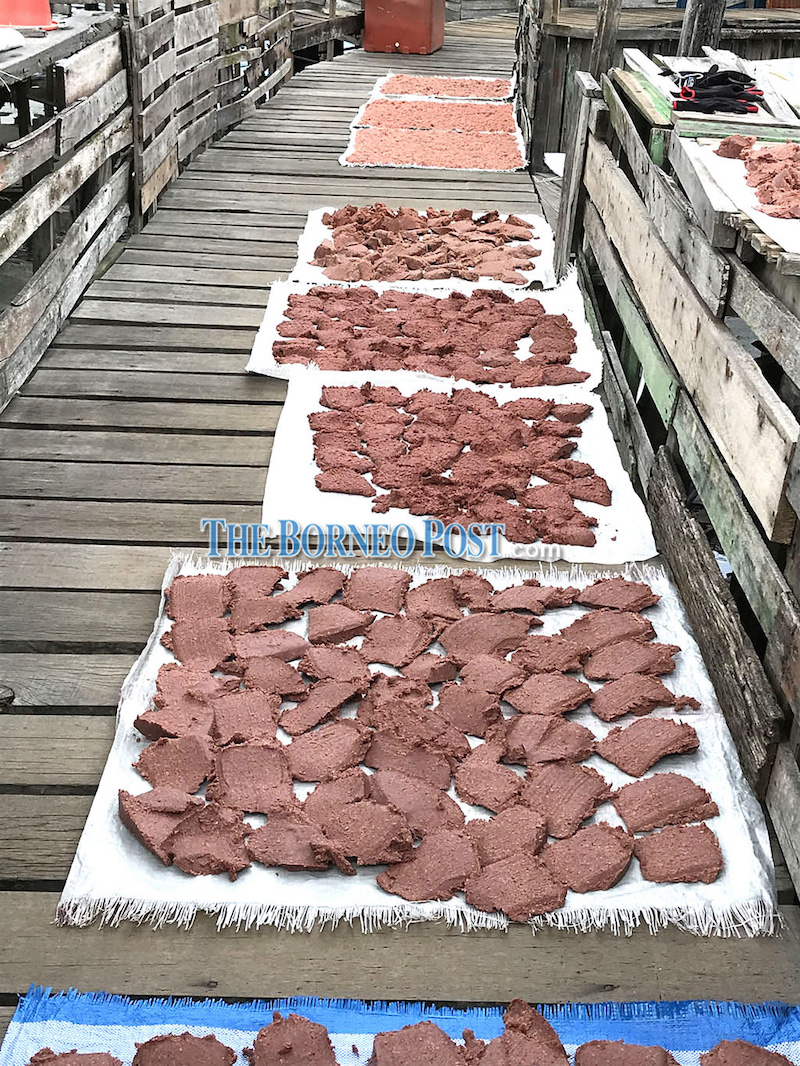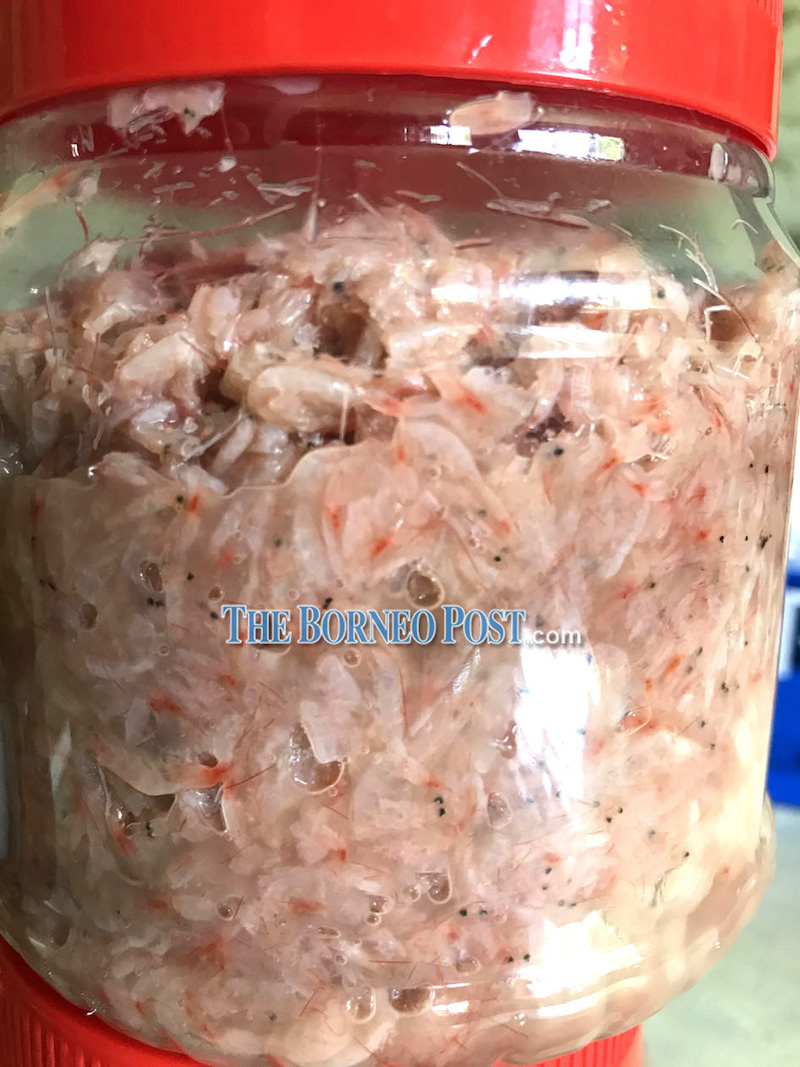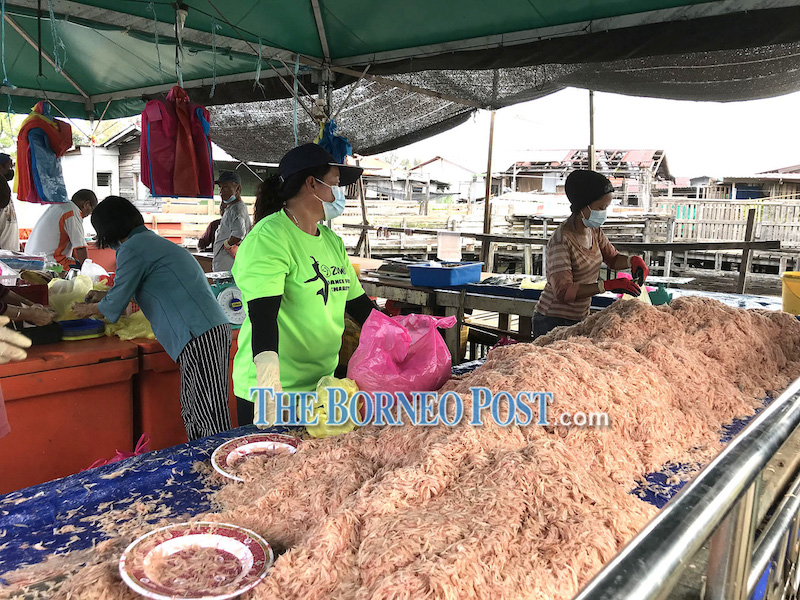MIRI, March 21 — “Bubuk sudah naik!” shouted the fishermen at Kampung Wireless. The beautiful riverine village, named after a wireless tower erected by the government in the 1930s at the edge of the then Miri town, was a hive of activity on a beautiful morning earlier this month.
Women from different ethnic groups had arrived to buy the freshly-netted bubuk or krill almost straight off the boats that had just returned from waters around Lutong.
Catching bubuk
The call of “Bubuk sudah naik!” traditionally referred to the times when the krill would swarm the coastal shores. About 10 years ago, it was even said that bubuk were so plentiful that they would wash onto the beach and no one cared. Many fishermen caught so much that they just gave the bubuk away.
In the 1960s, a kati (600 grammes) of bubuk was merely 30 cents. Today, bubuk is on average priced at RM6 per kg.
Catching bubuk in Miri is almost a religious ritual. The sea must be calm, with a shimmering of pink in the water indicating krill swarms below. The sky must not have grey clouds and the tide must be low.
In the past, at Luak Bay and the beach along the Peninsula/Long Jetty, hundreds of men and women would be ready to catch bubuk armed with triangular nets known as paka. They would walk into the waters and move along the shoreline, pushing the paka along the shallow seabed to scoop up the bubuk.
These days, triangular nets are fitted on fast-moving shoreline fishing boats powered by one or two 40 horsepower outboard engines. Able to move further from shore, the boats carrying two fishermen can stay out at sea for more than four hours and come home heavily laden.
This year is a good year. The bubuk is not only pink and pretty, but a good size – not too big and not too small.
Fishmongers
The fishmongers do brisk business as shoppers from all walks of life come to buy an average of 10kg each.
Some fishmongers happily tout their freshly-caught bubuk, shouting, “Enam ringgit. Enam puluh satu beg!”
Motorcycles, pick-up trucks, and even lorries arrive. Many smart saloon cars drive up near the stalls and park. Elegant and well-dressed fashionable ladies step out in high heels to buy what they need.
“Most of us are happy there is a good bubuk selling centre here by the riverside. We can even see the boats coming in. Most of us would be making cincalok (fermented krill) and belacan (krill paste) for our own use,” said one woman.
“Those who buy a lot would make a profit this year. I am only getting 3kg and that is enough for my own family’s consumption. This was the lifestyle of the past and it is still the lifestyle today.”
A fisherman named Ismail said many business operators were also quick to get their share of the bubuk.
“Some not only buy 5kg but 200kg! They will come with their lorries or pick-ups. At times the housewives won’t stand a chance. Hence the price goes up a little,” he shared.
Making belacan
According to Kampung Wireless resident Lata (name has been changed), whose husband is a fisherman, this year is a bumper season for bubuk.
She has painstakingly dried the krill to process into belacan, pounding and drying the patties on a clean wooden plank walkway leading to their boathouse. Lata has been keeping the area absolutely pristine in the past few days.
“If the sun is good, I only need three or four days to finish the whole process of making belacan. Praise God who has given me four good days of sunshine. I am earning my own pocket money this way. Other times I dry the fish my husband cannot sell in the market for our own consumption,” she said.
She uses a hardwood lesong or mortar to pound the semi-dried and fermented bubuk. Her alu or pestle is made of belian. Today an alu and lesong set similar to Lata’s could cost up to RM300 in the market.
“Most of us have a set from our parents, which sometimes has been passed on from our grandmothers,” Lata said.

Belacan-making is a very tedious process. To make the best paste, one has to use the highest quality bubuk with no impurities such as sand, small fish, bigger shrimp, or dirt.
According to Lata, this year the sea has been very clean and there has been hardly any sand in the water. The fishermen have also gone further out to sea to catch bubuk.
“There are not many flies here too, surprisingly even at this time of the year. May be we are just above the river water,” said Lata.
She explained that usually at this time of the year, after Chinese New Year, it is very sunny in Miri.
“So in our area, Kampung Wireless and other kampungs along the Miri River, people would start making belacan when the bubuk price is reasonable.
“Everyone who has the energy and skill would dry several kg of bubuk. Most of us only make a bit of belacan for family use. However, some sell cincalok and belacan, especially when they have a lot of people to work together. Some may even employ part-time workers,” she shared.
Going into detail, she explained belacan makers would first pound and dry the bubuk. This process of drying and pounding would be repeated three times. After the fourth time, the belacan becomes like a little brick — dry and ready for consumption.
“For sale, if we have a surplus. Sometimes relatives from outstation give us some money to buy bubuk and we make it on their behalf. This is our traditional way of helping our relatives who don’t live by the sea, but who love belacan,” she related.
She said now that fishmongers have set up stalls because the boats come in, things are very convenient for villagers. “We have ice suppliers coming here, and the various types of fishermen coming here. So in the morning, it is really busy,” she added.
Cincalok varieties
Lata revealed her simple cincalok is made using her mother’s old recipe. She uses salt, sugar, and a bit of cooked rice. After three days of fermentation in a big jar, her 3kg of cincalok is ready for bottling. She uses store bought plastic containers for the cincalok if she wants to give it away.

A long time ago, her mother would put cincalok in a glass jar. In those days, they also did not make much. Today, with refrigeration, Lata is able to make a bit more.
A shopper named Ling also bought 3kg of bubuk. Her style of making cincalok is slightly different. After fermenting the bubuk with salt and sugar for three days, she would add some Chinese rice wine to help preserve the cincalok, which she also refrigerates.
“I can cook many dishes using my own cincalok. But nowadays with age catching up, I eat less. My favourite way of cooking cincalok is to put some of it on top of a slice of tofu, with some ginger and garlic, and chillies, and then steam.
“That is really a nice dish for lunch. It is tasty and many people do not realise that we Asians actually have, for a long time, discovered the fifth taste. Cincalok is delicious and full of umami,” she said.
Some friends have introduced a Korean style of cincalok sambal to go with fried beehoon (rice vermicelli) and even kolok beehoon. It is definitely a flavour enhancer.
Adding some onions, chillies, and limes to cincalok really makes it a good dipping sauce. Cincalok is therefore a very handy and versatile ingredient to use.
March seems to be a happy month for Mirians. In spite of the Covid-19 pandemic, which has caused so much anguish, loneliness, isolation, and fear, the arrival of bubuk, and the ensuing making of cincalok and belacan, seem to have energised city folk. Cincalok and belacan should really be recognised as heritage food in Malaysia.
One woman who went home from Kampung Wireless with a 10kg bag of bubuk had such a happy smile on her face. It is remarkable indeed that such a small little crustacean can give so much happiness. — Borneo Post Online






















